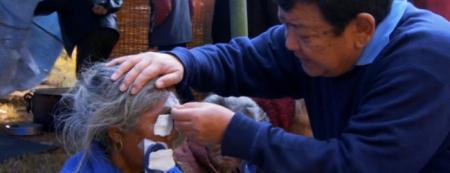HWN Jobs
- A MARKETING AND LOGISTIC OUTFIT JOBS
- MEDIFIELD HEALTH SCREENING SUITE (2 SLOTS) JOBS
- MALARIA CONSORTIUM (NOVEMBER) JOBS
- THE PALLADIUM GROUP (LATEST) JOBS
- MED IN SPECIALIST HOSPITAL (PMO) JOBS
HWN Blogs
- Classical heart healthy foods on HWN BLOGS
- Classical Warning Signs When The Human Liver Begins To Fail on HWN BLOGS
- Myths About Hygiene, Soaps, Germs, Sweat and Smell on HWN BLOGS
- Hernia does not heal on its own on HWN BLOGS
- Classical Essential Oils That Improves Focus Cum Memory on HWN BLOGS
news - Dr Sandut Ruik who cures blindness with fascinating speed on HWN SPECTACLES back to all News
Dr Sandut Ruik who cures blindness with fascinating speed on HWN SPECTACLES

Over the last three decades Dr. Sanduk Ruit, a 61-year-old Nepali ophthalmologist, has successfully treated over 100,000 people across Asia and Africa through a simple suture-less cataract microsurgery technique that costs only $25 per patient. In mere 5 minutes, Dr. Ruit can make a small incision in his patient’s eye, remove the cloudy cataract impairing her vision, replace it with a low-cost intraocular lens, and change someone’s life forever. He has taught his “Nepal method”, which is now being studied in United States medical schools, to countless other eye surgeons in parts of the world as isolated as North Korea.
His sister’s death of tuberculosis, a preventable and treatable disease, motivated Ruit, then 17, to become a doctor. In 1981, Ruit completed a three-year ophthalmology residency at the All India Institute of Medical Sciences in Delhi, India and returned to Nepal. While working on the Nepal Blindness Survey, he met Fred Hollows, an Australian ophthalmologist. The duo decided to eradicate avoidable blindness among the world’s poorest people with limited access to public health services, who, they thought, deserved safe, affordable and high-quality eye care.
In 1986, Dr. Ruit studied with Hollows for 14 months at Sydney’s Prince of Wales Hospital in Australia. In 1988, Dr. Ruit, Fred and Gabi Hollows, and their team started the Nepal Eye Program Australia (NEPA) – which joined The Fred Hollows Foundation fold when it was founded in 1992. In 1994, when Dr. Ruit returned to Nepal, fundraising from NEPA and The Fred Hollows Foundation helped establish the Tilganga Eye Centre – an eye hospital in Kathmandu dedicated to providing world-class eye care to the people of Nepal.
For those who lose an eye, Tilganga makes realistic-looking prosthetics that cost $3, compared to $150 for an imported false eye. For those unable to reach the center, or who live in otherwise isolated rural areas, Dr. Ruit and his team set up mobile eye camps, often utilizing tents, classrooms, and even animal stables to serve as makeshift operating rooms.
We are all born with mission and it’s a very special thing. I’m at a stage where I’ve realized that my mission is to learn how best I can restore the sight for others, and how I can help others to do that multiply that effect with training. I’m trying to set up other centers around the world,” he says.
Source: WWWN, HWN Africa.
HWN News
- First Polish infant to survive on extreme dialysis on HWN MEDICAL MIRACLES
- Drug resistant tuberculosis end game on HWN INSIGHTS
- Too many women opting for caesarean sections (CS) to give birth on HWN SEX EDU
- The intelligent, strong and fearless Nurse that conquered Ebola on HWN ARCHIVE
- Medhi Benatia, down with injury on HWN SPORTS






